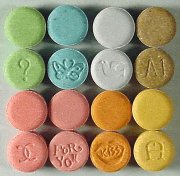Ecstasy: How Dangerous is This Wildly Popular Drug?
by SixWise.com
In February 2004 a 16-year-old girl in Connecticut went to
a house party with some friends. She took a powdered form
of the popular drug known as ecstasy with her friends, went
into seizures and later died. In April 2004, a 14-year-old
girl in California took ecstasy at a sleepover with two friends
and died the next day from an overdose.
These stories are not rare-in fact, 2.6 million teens report
having experimented with ecstasy in 2003 and hundreds of teens
have died taking such drugs, according to the Substance Abuse
and Mental Health Services Administration (SAMHSA). Ecstasy
is used by kids in their early to late teens and early 20s
because it promotes a euphoric feeling by releasing a chemical
in the brain called serotonin (the same chemical that, when
lacking, is linked to depression).
This drug, chemical name 3-4 methylenedioxymethamphetamine,
or MDMA, is different from other illegal drugs in that many
kids mistakenly believe it is safe. Common among white, middle-
and upper-class kids, ecstasy-also called the hug drug, beans,
Adam, XTC and the love drug-is thought of as a safe way to
get an intensely pleasant, high feeling.
|

Ecstasy pills can be brightly colored and often contain
cartoon characters and fun logos that appeal to kids.
|
It combines both stimulant and hallucinogenic properties
that allow kids to stay awake and full of energy, which is
why it's a popular drug at raves (all-night dance parties)
and dance clubs. The aspirin-sized pills are geared toward
kids and even contain cartoon logos and shapes like crowns
and hearts.
It does appear that kids and parents are waking up to the
real dangers of this drug, as the 2003 National Survey on
Drug Use and Health found that among youths aged 12 to 17,
41 percent fewer said they had used ecstasy in the past month.
However, many kids are still experimenting:
-
3.3 percent of kids 12-17 have tried it
-
15 percent of those aged 18-25 have tried it
-
One in nine teenagers has tried it
Despite these high numbers, close to half of parents (41
percent) have never talked to their kids about ecstasy, according
to SAMHSA, but 90 percent believe it's an extremely risky
drug to use.
Ecstasy's Damaging Effects
|
 Beware
if Your Child Suddenly Starts Carrying These Items Associated
With Ecstasy Beware
if Your Child Suddenly Starts Carrying These Items Associated
With Ecstasy
The following paraphernalia are often carried by ecstasy
users, either to stimulate senses, hide pills or relieve
jaw clenching:
- Pacifiers
- Lollipops
- Candy necklaces
- Glow sticks and/or glowing jewelry
- A child-like backpack
- Mentholated rub
- Surgical-type masks
|
Many kids are drawn to the short-term "good feelings"
that ecstasy creates, but here is a sample of the lasting
damage even one ecstasy pill can cause:
-
Severe dehydration
-
Seizures
-
Strokes
-
Dramatic increases in body temperature (death by overheating
is not unusual)
-
Muscle breakdown
-
Kidney failure
-
Liver and heart failure
-
Damage to hormornal systems
-
Potential brain damage with repeated use
|
Would You Know if Your Child Were Using Ecstasy?
Here are 17 warning signs that your child could be
using ecstasy:
- Dehydration
- Clenching of the jaw and/or grinding teeth
- A sore jaw
- Unusual displays of affection
- Pronounced mood swings
- Loss of inhibitions
- Transfixion on sights and sounds
- Chills or sweating
- Muscle tension
- Nausea
- Confusion
- Difficulty concentrating;
- Tremors
- Sleep problems
- Severe anxiety
- Panic attacks
- Depression
|
If you suspect that your child may be using this drug, see
the box at right for 17 warning signs, it's important to talk
to him immediately. If your child is young and tried a drug
one time, you may be able to deal with the drug use on your
own, however, if your child is older or you suspect he is
a regular user, there are professional social workers, nurses,
drug counselors, psychologists and psychiatrists who can help.
Ask your child's school, your family physician or a community
health center for a referral of where to get help. SAMHSA,
of the U.S. Department of Health and Human Services, also
has an online substance abuse treatment facility locator at
http://dasis3.samhsa.gov/
as well as many other online resources to help keep your kids
drug-free: http://www.health.org.
Of course, speaking openly with your children about the dangers
of drug use well before they reach their teenage years is
one of the best preventive measures you can take.
Ecstasy's Future Looks Dim
There is hope on the horizon for limiting the harm this "trendy"
drug inflicts. In March 2004, the alleged leader of an international
Ecstasy ring that supplied 15 percent of the U.S. ecstasy
market was arrested along with more than 130 defendants in
16 cities across the United States. The investigation, dubbed
Operation Candy Box, was geared toward removing this dangerous
drug from the U.S. market.
Karen P. Tandy, U.S. Drug Enforcement Administration (DEA)
administrator said, "For the first time in all law enforcement,
DEA has measured the impact of this operation, revealing that
Operation Candy Box decimated the U.S. MDMA market-dramatically
reducing MDMA availability, slashing its purity, and raising
its price."
Sources
Ecstasy:
Parents Need to Check In
What
Parents Should Know About
International
Ecstasy Investigation
DCF
Report Released on Overdose Death